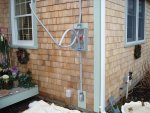K_Buz
Member
- Location
- Southeastern Wisconsin
I posted this question elsewhere and got one response to the effect of "because it is", but I'm looking for something more concrete.
In another thread running SEU cable inside/outside/inside to feed a attic furnace is being discussed. I am studying for my Journeyman's license so I've been trying find all these code issues on my own.
While researching the question, I looked in 338 and found that type SE could not be used for outdoor branch circuits and it had to be protected from physical damage. Type USE could not be used to feed an indoor circuit. However, I do not see type SEU specifically listed.
I have looked elsewhere (on the internet) to see if type SEU is rated to be outside, and in other parts of the country (I'm in WI) it is common to run SEU exposed for the service...see picture below.

My confusion is as follows:
1) If this cable falls into the category of type SE cable, how is it not subject to physical damage?
2) If this cable falls into the category of type USE cable, how does it not violate 338.12 B 2?
3) (and most likely) If this cable does not fit in either of the categories, where can I find the section of the code that talks about type SEU cable?
In another thread running SEU cable inside/outside/inside to feed a attic furnace is being discussed. I am studying for my Journeyman's license so I've been trying find all these code issues on my own.
While researching the question, I looked in 338 and found that type SE could not be used for outdoor branch circuits and it had to be protected from physical damage. Type USE could not be used to feed an indoor circuit. However, I do not see type SEU specifically listed.
I have looked elsewhere (on the internet) to see if type SEU is rated to be outside, and in other parts of the country (I'm in WI) it is common to run SEU exposed for the service...see picture below.

My confusion is as follows:
1) If this cable falls into the category of type SE cable, how is it not subject to physical damage?
2) If this cable falls into the category of type USE cable, how does it not violate 338.12 B 2?
3) (and most likely) If this cable does not fit in either of the categories, where can I find the section of the code that talks about type SEU cable?

